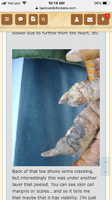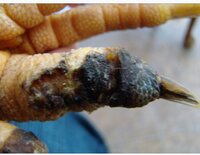Here is a picture progression of my first one. So you get an idea. I didn’t know what to expect with mine —what would happen next and when— so I did document for others Here on BYC .
January 21-23

Jan 27-29

You can see the body’s response to the frostbite happening here I think. Tissues are walling off. I thought the pink was good at the time and it was going to heal but the body is cutting its losses so to speak. February 7.

February 14. Eschar is forming up.

March 9. It had actually been this way for a bit before I got the camera down to the coop.

March 12th. Looks ready to crumble off but not quite yet.

Toe sloughed April 8th.

Week or two for the skin to cover the tip. I did bandage again at this time. Mud season too! Ugh
July. Happy rooster grazing.

January 21-23
Jan 27-29
You can see the body’s response to the frostbite happening here I think. Tissues are walling off. I thought the pink was good at the time and it was going to heal but the body is cutting its losses so to speak. February 7.
February 14. Eschar is forming up.
March 9. It had actually been this way for a bit before I got the camera down to the coop.
March 12th. Looks ready to crumble off but not quite yet.
Toe sloughed April 8th.
Week or two for the skin to cover the tip. I did bandage again at this time. Mud season too! Ugh
July. Happy rooster grazing.
Attachments
Last edited:








